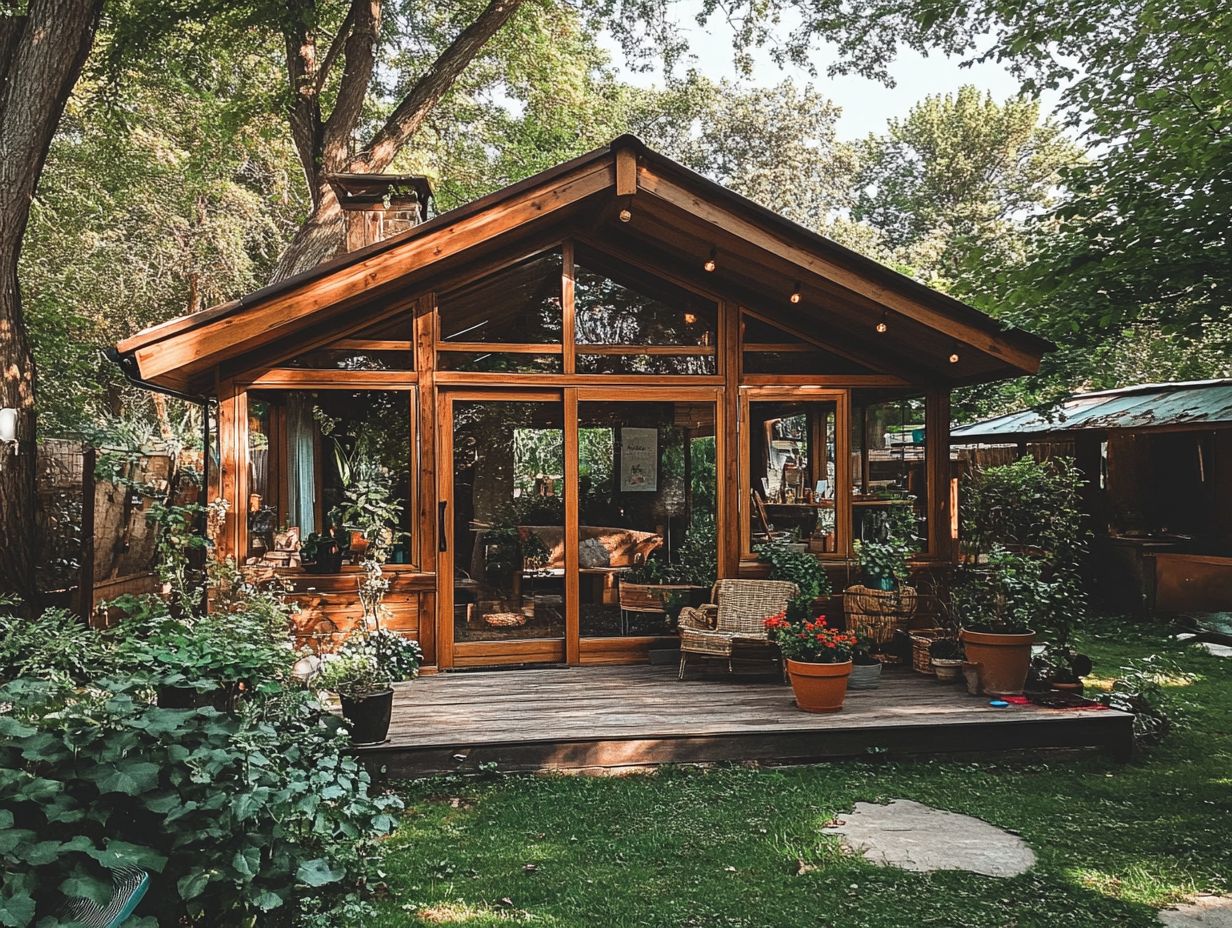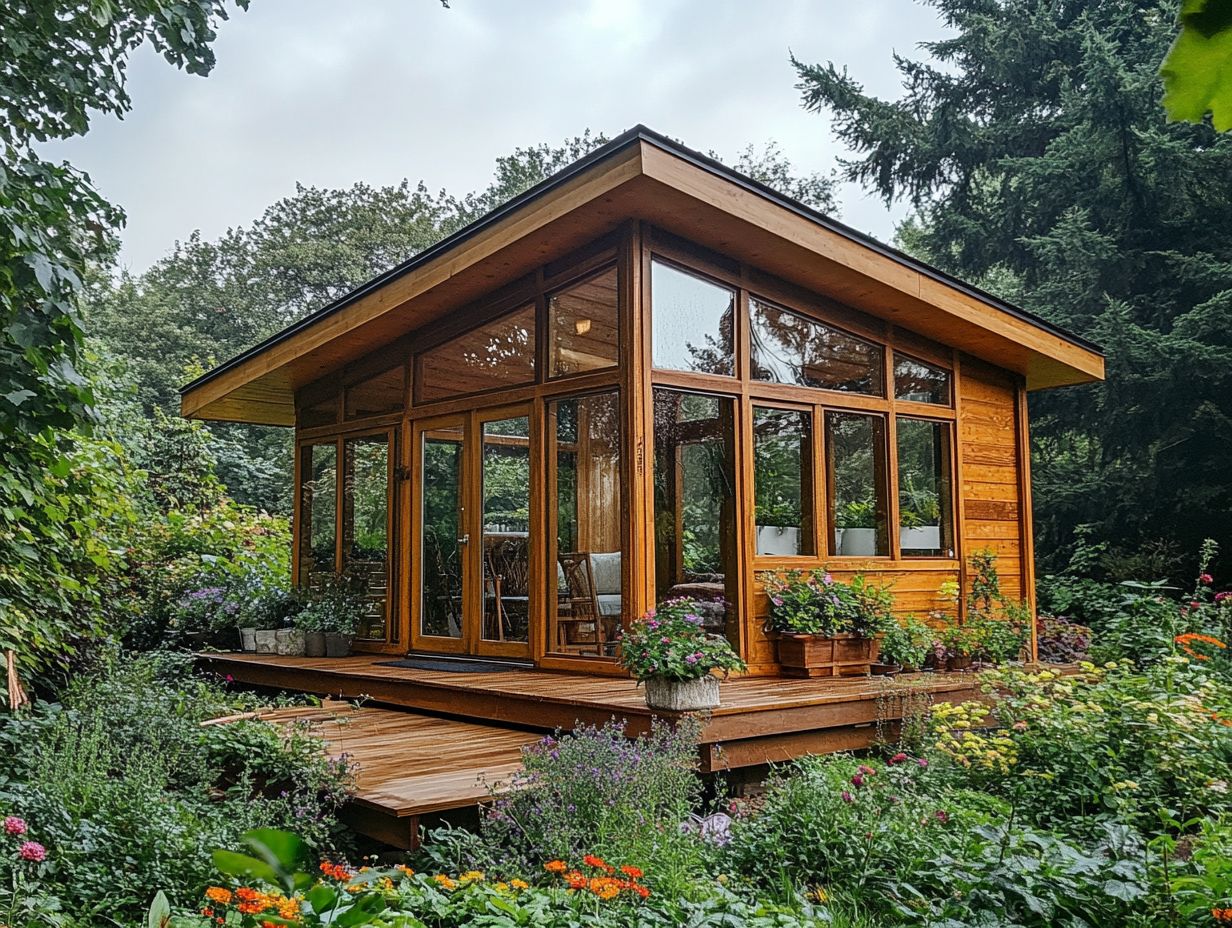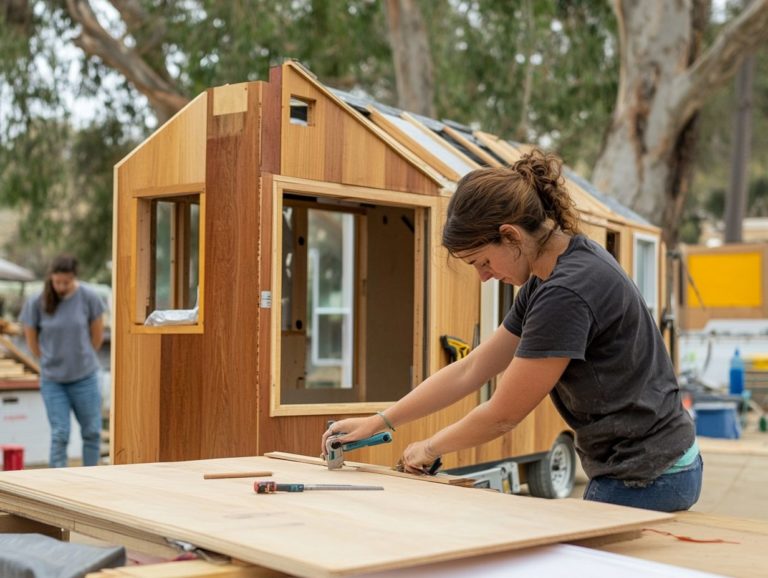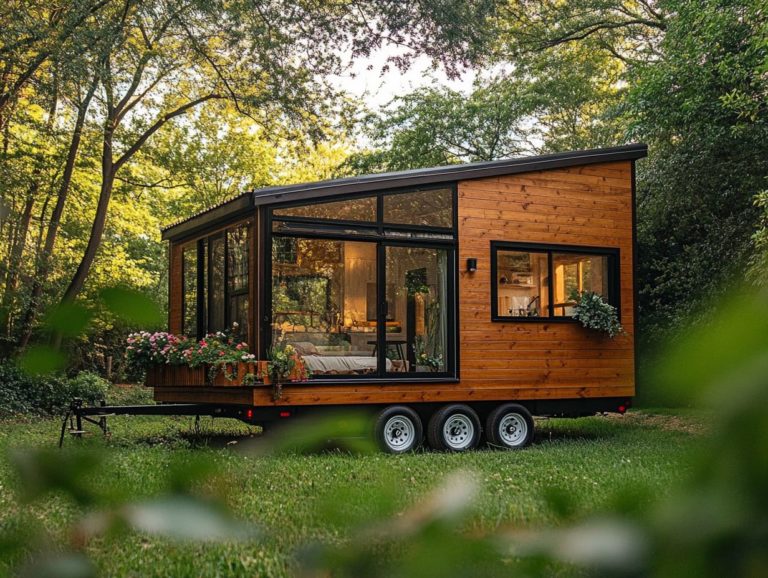What Is the Tiny House Movement?
The Tiny House Movement has surged in popularity lately, appealing to those who aspire to a simpler life, a more sustainable lifestyle, and enjoy the mobility advantages of living in tiny homes.
In this article, you ll delve into the essence of tiny houses, exploring their history and evolution while uncovering the motivations behind this alternative way of living and the financial benefits associated with building tiny houses. From financial advantages to environmental considerations, you’ll gain insight into the challenges that accompany the downsizing journey.
Whether you’re contemplating building your own tiny home or simply wish to expand your knowledge, this guide is packed with valuable insights that will empower you to dive into tiny living!
Contents [hide]
Key Takeaways:

- The tiny house movement is a social and architectural movement that promotes living in small, simplified homes.
- Financial and environmental considerations are major reasons for choosing tiny house living.
- Living in a tiny house comes with challenges such as space constraints and potential zoning and legal issues.
Understanding the Tiny House Movement
The Tiny House Movement has arisen as a thoughtful response to the complexities of modern living, promoting a lifestyle that revolves around tiny homes. These homes offer mobility and significant financial benefits. They also promote a simplified way of life.
At the heart of this movement lies a philosophy of reduced consumption. It emphasizes minimal environmental impact, aiming to redefine home ownership. This movement also delivers affordable housing options for individuals and families.
Influential advocates like Jay Shafer and Dee Williams have passionately championed this cause, inspiring a vibrant community committed to the principles of sustainable living through innovative tiny house designs.
Defining Tiny Houses
Tiny houses, often dubbed small houses or tiny homes, including tiny houses on wheels, are compact living spaces crafted for efficiency and simplicity. They promote a minimalist lifestyle that encourages you to prioritize experiences over material possessions.
Typically ranging from 100 to 400 square feet, these charming abodes are ingeniously designed with furniture that serves multiple purposes, optimized storage solutions, and open floor plans that maximize every inch of usable space. Many of them incorporate sustainable features like solar panels and rainwater collection systems, aligning beautifully with eco-friendly practices, which significantly reduce their environmental impact.
The DIY building trend further enhances the tiny house movement, inviting you to take on the rewarding challenge of constructing your own home. This journey is an exciting chance to personalize and creatively design your own space! Embracing this hands-on approach gives you the power to adopt a more sustainable and cost-effective lifestyle, making every square foot truly count.
History and Evolution of the Movement
The Tiny House Movement truly picked up steam during the 2008 recession, driven by individuals like you searching for innovative, affordable housing solutions. Visionaries such as Jay Shafer and Dee Williams founded companies like Tumbleweed Tiny Houses to champion the minimalist lifestyle, influencing the growth of the tiny house movement.
The trend toward smaller living spaces also has roots in earlier social and economic shifts, finding its voice in the aftermath of the 2008 recession and blossoming by 2014. By 2014, significant milestones, such as the inaugural Tiny House Conference and the rise of online platforms dedicated to design inspiration and construction tips, greatly enhanced the movement’s visibility.
Influencers like Ryan Mitchell, through his blog The Tiny Life, have been instrumental in educating the public about the myriad benefits of downsizing. Meanwhile, various municipalities have started to rethink zoning regulations to welcome these compact homes.
As the movement gained traction, communities embraced this lifestyle, cultivating a unique culture centered on sustainability and financial freedom.
Reasons for Choosing Tiny House Living
Opting for tiny house living presents a wealth of advantages. You’ll enjoy substantial financial benefits, including lower mortgage payments and reduced utility costs.
This lifestyle champions an environmentally conscious approach, emphasizing reduced consumption and sustainable practices that can make a positive impact on the planet.
Financial Considerations

Financial considerations are important when thinking about tiny house living. You might find that the reduced costs associated with home financing and the potential for affordable housing make this lifestyle particularly appealing.
This shift often grants you freedom from traditional mortgage payments, enhancing your financial flexibility and alleviating debt burdens.
As you evaluate loan options, you may discover that smaller, more manageable mortgages or even personal loans present viable alternatives, easing your transition into tiny living.
The tiny house community is brimming with resources, including workshops and online forums, where you can gather valuable insights on budgeting for this lifestyle. By understanding the broader economic impacts from utility savings to land affordability you’ll realize that tiny house living is not merely a trend; it s a sustainable financial choice that resonates with your values.
Environmental Benefits
The environmental benefits of tiny house living are truly remarkable. Choosing a tiny home means you can drastically lower your impact on the environment through lower resource and energy consumption.
Designed to maximize space and efficiency, these residences often feature energy-efficient appliances which are appliances that use less energy and renewable energy sources, such as solar panels.
This not only helps you minimize utility costs but also reduces your reliance on fossil fuels. The focus on compact designs encourages innovative layouts and multi-purpose furniture, which means furniture that serves more than one function, like a sofa that also serves as a bed.
Many tiny homes are built using sustainable materials like reclaimed wood and recycled metal, showcasing the potential for eco-friendly building practices.
As a result, when you embrace this lifestyle, you actively contribute to a more sustainable future, promoting environmental stewardship and raising awareness about the impact of traditional housing on our planet.
Challenges of Living in a Tiny House
While embracing tiny house living presents many advantages, it also comes with its own set of challenges of tiny homes that you must navigate.
Space constraints demand innovative designs that maximize every square inch. Zoning and legal issues can complicate the journey to home ownership.
Space Constraints
Space constraints in tiny house living require thoughtful design and organization. This often inspires innovative solutions that maximize functionality while crafting a comfortable home environment.
By incorporating multifunctional furniture, like sofa beds or foldable tables, you can effortlessly adapt your space for various activities, from unwinding after a long day to entertaining guests.
Efficient storage solutions, such as built-in cabinets and under-bed storage, enhance your available square footage, ensuring that every inch serves a purpose.
A well-considered aesthetic that blends light colors with strategic lighting creates an illusion of openness, making even the coziest corners feel inviting. Smart design choices are essential for transforming limited spaces into welcoming and multifunctional havens that reflect your lifestyle.
Zoning and Legal Issues
Zoning and legal issues present significant challenges within the Tiny House Movement. Many regions impose strict regulations that can obstruct tiny homes as an affordable housing solution.
The complexity of these regulations often stands in the way of your dream of minimalistic living. You may feel frustrated and uncertain about where you can legally place your dwelling. This situation is further complicated by building codes that differ not only from state to state but also between local jurisdictions. This creates a patchwork of rules that can make compliance daunting.
Advocates in the tiny house community, including influencers like Christopher Smith and Merete Mueller, are working to address these hurdles. They push for legislative reforms, engage in community outreach, and promote awareness of sustainable living options through platforms like YES! Magazine and Climate Desk.
Through collaborative efforts among tiny house enthusiasts, local governments, and housing advocates, a more accommodating legal framework is being fostered. This framework supports innovative housing solutions for those seeking a simpler, more fulfilling lifestyle.
How to Join the Tiny House Movement

Join the Tiny House Movement for an exciting adventure that brings simplicity to your life! You ll have the chance to build your own tiny house, dive into engaging DIY projects, and connect with a supportive tiny house community that shares your passion.
Explore a variety of tiny house designs tailored to your unique needs and preferences. This experience is not only fulfilling but also deeply personal.
Building and Designing a Tiny House
Building and designing a tiny house requires a thoughtful blend of creativity and practicality. Use DIY techniques to craft unique and functional designs that reflect your individual lifestyle.
With options ranging from reclaimed wood to innovative eco-friendly materials, which are good for the planet, you have a wealth of resources at your fingertips to bring your vision to life.
The materials you choose will significantly influence the aesthetic appeal, as well as the durability and sustainability of your tiny abode.
As you embark on this exciting journey, explore space-saving solutions like multifunctional furniture to maximize utility without sacrificing style. Incorporate elements such as natural light through strategically placed windows to enhance both ambiance and perception of space.
With careful planning and imaginative design, you can satisfy both aesthetic and functional needs, ensuring your tiny house feels uniquely yours.
Alternative Options for Tiny Living
If you’re considering the allure of tiny living, explore mobile tiny homes for remarkable flexibility and adaptability. This lifestyle allows you to travel while embracing a minimalist ethos, all within the welcoming embrace of the tiny house community.
Renting a tiny home offers a cost-effective opportunity to test this lifestyle without a hefty financial commitment. Tiny home villages are popping up across the country, cultivating a sense of camaraderie and shared resources. These charming residential enclaves provide affordable housing solutions and champion sustainable living practices.
Together, these arrangements cater to various needs, attracting young professionals, retirees, and eco-conscious families eager to embrace a simpler, more intentional way of living.
Is Tiny House Living Right for You?
Determining whether tiny house living is the right choice for you requires a thoughtful examination of various factors, such as the allure of a simpler lifestyle, the financial advantages, and the unique challenges that tiny homes may present.
As you explore the tiny house movement, reflect on your personal values, priorities, and lifestyle preferences. If you’re curious about the concept, find out what a tiny house is and why choose one. Downsizing often leads to less clutter and more peace of mind, fostering a sense of tranquility and focus.
However, limited square footage can present challenges, especially for families or hobbies that require more space. It s essential to evaluate not just the initial investment and ongoing costs but also how this lifestyle aligns with your long-term goals, including sustainability and community engagement.
Taking the time to assess these considerations is crucial! It empowers you to make a well-informed and fulfilling decision.
Frequently Asked Questions
What Is the Tiny House Movement?

The Tiny House Movement is a social and architectural movement that supports living in small, often movable homes that are typically less than 500 square feet in size.
Why Did the Tiny House Movement Start?
The Tiny House Movement emerged as a response to the increasing cost and size of traditional housing, as well as a desire for a more minimalist and sustainable way of living.
How Did the Tiny House Movement Gain Popularity?
The movement gained popularity through exposure on social media, television shows, and documentaries. It also attracted attention for its unique and innovative design solutions.
Are Tiny Houses Legal?
The legality of tiny houses varies by location and local zoning laws. Some places have specific regulations for tiny houses, while others may categorize them as an accessory dwelling unit or a recreational vehicle. Always research and comply with local laws and regulations before building or living in a tiny house.
Can You Build Your Own Tiny House?
Yes, you can build your own tiny house if you have the necessary skills and knowledge. However, it is recommended to consult with professionals and conduct thorough research before starting the building process to ensure safety and compliance with building codes.
What Are the Benefits of Living in a Tiny House?
Living in a tiny house can offer various benefits, including lower costs for purchasing and maintaining a home, reduced environmental impact, and a simpler, less cluttered lifestyle. It also allows for more mobility and flexibility in terms of location.
Ready to explore tiny house living? Start your journey today!






